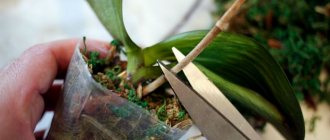International name:
Synonyms:
Characteristics:
| Complexity: |
| Development cycle: |
| Light mode: |
| Watering mode: |
| Temperature: |
| The soil: |
| Key Feature: |
Foliage color
Bud color
Dimensions Flower sizes
Taxonomy:
| Domain: |
| Kingdom: |
| Department: |
| Class: |
| Order: |
| Family: |
| Genus: |
Want to know where to cut the stem of your Dendrobium Orchid after it has finished blooming? You are not alone! We receive many similar questions.
The fact is that these flowers are anatomically diverse, and many people are simply not sure where the arrow ends and the trunk begins. So we're going to talk about what to do after two common types of Dendrobiums bloom .
Basic care issues after flowering
Caring for a Dendrobium orchid after flowering at home is required so that the plant can please us again with its beautiful blooms as soon as possible. On average, this species blooms from 8 to 12 weeks and is one of the most popular varieties of orchids. The main condition that must be met in any situation is the difference between day and night temperatures.
The Dendrobium orchid is very popular among amateur gardeners.
After the orchid has bloomed, the first thing to do is :
- Stop watering;
- Get rid of the old peduncle;
- Ensure a decrease in temperature, namely: move the flower to a cooler place . This way it can get ready to bloom again.
Experienced gardeners recommend not placing the plant in a dark place, as it may “hibernate,” which means stopping growth .
The Dendrobium orchid reproduces in two ways :
- Propagation by cuttings;
- And propagation by peduncle.
IMPORTANT! For sufficient lighting, especially in winter, experts recommend purchasing a phytolamp.
Brief characteristics and features of the orchid
The plant has spread massively to Nepal, India and Thailand. Flowers that form numerous lush inflorescences give decorative beauty. The orchid forms buds in groups. There are no single copies.
Important! As the age of the orchid increases, the number of buds produced becomes greater.
Nobile does not need to create a specific temperature regime. In summer, the plant normally exists at room temperature from +22 to +28°C. In winter, the orchid can be kept indoors, where the air warms up from +15 to +20°C. Short-term temperature rises to +32°C are not scary. However, during hot weather you need to increase the humidity.
The orchid is light-loving, but exposure to the sun is dangerous for it. The flower is placed on the windowsill on the west or east side. For normal development, the plant requires 12 hours of daylight. It is increased by illumination from a phytolamp.
Watering is carried out not according to a schedule, but taking into account the condition of the substrate. In summer, the frequency is approximately 3 times a week. In the winter, spring and autumn months, the frequency decreases to 1 time per 10 days.
For abundant flowering, the orchid is “bathed” under a warm shower. Allowable water temperature is up to +40°C. Place the plant with the flowerpot in the bathroom, a large bowl or sink, and water it from a watering can for 1-2 minutes. After the shower, the orchid is left to dry for half an hour.
Attention! After a shower and drying in the axils of the leaves, blot the remaining water with a napkin. Rot will appear on the plant due to dampness.
Flowering usually begins in February and continues until the end of March. Some plants are capable of producing buds twice a year. If everything is done correctly, the orchid will consistently delight you with its flowering. What further care Dendrobium needs is worth understanding in detail.
How to determine if an orchid needs replanting?
The orchid has faded, what to do next? Do you need to understand whether the plant needs replanting? This can be determined by three key parameters :
- Soil condition;
- Condition of the ground part;
- Condition of the root system.
Most often, beginners encounter a problem when the flowering starts after purchasing an orchid in a store. If the plant is completely healthy and the soil has not yet decomposed, then there is no need to disturb the orchid.
Replanting a flower should be done only when the substrate begins to rot , thereby causing harm to the roots.
The average time for soil to decompose is 2-3 years. How to determine what condition the soil is in :
- Pieces of bark crumbled;
- The soil does not dry out after watering.
If the orchid has been living on your windowsill for about a year, after flowering you should definitely replant it . You should focus on the growth of pseudobulbs; as soon as they reach 10 cm in height, you can begin replanting.
The best time to replant an orchid is when new growth begins . In this case, the flower adapts much better to new conditions and new soil.
The condition of the root system is a rather serious signal ; if it does not have enough space in the old pot, you should immediately start replanting, because... this can lead to the death of the orchid.
Why might this not happen?
Why Dendrobium Nobile may not bloom:
- The soil in which the flower grows is more than 3-4 years old.
- The plant lacks mineral salts.
- Pests have infested.
- The conditions for keeping the orchid have been violated.
- If the peduncle has not formed, and the children continue to appear. The reason lies in the lack of light and increased temperature around.
- It has not bloomed for more than 1.5 years. The plant has a constant lack of light and there is no rest period.
- Only the blossoming flowers begin to dry. Causes: pests, elevated temperatures or excess moisture.
Fact . An orchid may not bloom if it is infested with common snails.
Dendrobium variety Berry Oda may not bloom for a very long time. This is due to the fact that one of the flower development cycles has been disrupted.
There are four development cycles in total:
- Vegetation. The appearance of new shoots.
- Development of new pseudobulbs from new shoots.
- Rest period. Peduncles are laid.
- Bloom. Time for flowers to bloom.
Therefore, to correct the situation, you need to do the following so that the plant shoots an arrow:
- Arrange additional lighting.
- Lower the temperature.
- Limit watering.
We also have useful articles on replanting Dendrobium orchids and the causes of yellowing leaves and how to combat this problem.
When to do a planned transplant?
Experts consider the most favorable time for transplantation to be the beginning of growth .
Dendrobium orchids should be repotted when they begin to grow.
Before starting the procedure, you should stock up on fresh substrate , a new pot and tools for removing rotten parts of the root system, which must be disinfected.
After removing the faded orchid, you should carefully remove the old soil . To thoroughly clean the orchid roots, you should rinse them under warm water.
IMPORTANT ! Before transplanting, you should carefully examine the flower for the presence of parasites and diseases. Next, you need to dry the plant for 8-10 hours. The bottom of the new pot should also be treated with an antiseptic.
Lighting
The Dendrobium Nobile orchid is a light-loving orchid, but within the group itself, light preferences are heterogeneous.
You can buy two hybrids of different colors, place them on one window, and one will produce 2-3 generations of new shoots throughout the year, and the other will slowly but surely develop the only one that appeared in May-June.
Different genes are dominant in different hybrids. White and pale pink contain less light-loving natural orchids, while rich red or yellow ones contain more light-loving ones.
Southern, southwestern and western windows are suitable for any representatives of Dendrobium Nobile, but for the rest you will need to determine their suitability experimentally.
If, after moving the orchid to another place, the newly formed pseudobulbs are shorter than the previous ones, then this is an indicator of an excess of light.
Long and thin pseudobulbs (compared to the store-bought version, which was thicker and shorter) obtained on an eastern or northern window indicate a lack of light.
If the orchid does not bloom within 18 months, then you need to look for another place for it or install artificial light lamps in addition to regular lighting.
In the summer, it is advisable to take Dendrobium Nobile into the garden, onto the balcony, loggia. Or ensure excellent circulation of fresh air by ventilating the room as often as possible.
Remember! An important factor in creating optimal conditions is observing the orchid. An indicator of an optimal environment is the growth of green mass.
In our latitudes, the lighting in winter is very low; there is not enough light for the development of new shoots, so they appear in the spring.
They turn into a fully formed pseudobulb around October-November.
What to do with faded pseudobulb?
Pseudobulb is a storage organ that nourishes new shoots , providing favorable conditions for their growth.
Each false bulb blooms only once.
Experienced flower growers note that if only the upper part of the orchids has bloomed, under the right care conditions it is possible to ensure flowering on another part of the plant. It is not recommended to cut pseudobulbs; it can be harmful.
You need to wait not only for the end of flowering, but also for the moment when the leaves begin to fall and the false bulb begins to dry. Only in this case is it recommended to cut off the pseudobulb.
How to make a plant bloom ahead of schedule?
Experienced flower growers usually do not recommend forcing an orchid to bloom before its natural time, since in the future the flower may experience various growth problems.
But, if you still have a desire or need for such an action, and you really want to see buds on your favorite plant, then you should do the following work:
- Change the soil and fertilize it.
- Trim the lower leaves.
Necessary activities
Providing favorable conditions after flowering is the responsibility of every orchid owner. You should begin daily care after completing the following steps :
- First of all, you should cut off the peduncle ;
- It is not recommended to cut off the stem completely , because it is in this part of the plant that nutrients accumulate, which contribute to the further growth and flowering of the orchid;
- The resulting wounds should be carefully treat with mixture from charcoal and ground cinnamon. Many beginners skip this stage, but this can lead to the death of the plant.
After flowering, the orchid begins a period of rest.
In fact, immediately after flowering, the plant enters a dormant period . At this time, the flower does not need regular watering, but the optimal climate must be maintained in any case. You should also be careful when using various fertilizers.
IMPORTANT! Flower growers recommend using cling film to protect the soil from getting fertilizer. A spray bottle is perfect for fertilizing. It is recommended to use this procedure 2 times a month.
Dendrobium loves moisture , especially in the summer-spring period, as well as during the breeding season. The preferred watering method is submersion.
But this only applies to the hot season; during the dormant period, watering is recommended to be kept to a minimum . Water the plant only after the substrate has completely dried.
With proper care, the Dendrobium orchid will delight you with its blooms.
No matter how strange it may sound, during periods of active growth and flowering, experts recommend abandoning fertilizers .
The main periods when the plant needs feeding are the initial stages of growth and development. Continue feeding until cold weather sets in.
When choosing a fertilizer, preference should be given to fertilizers with a high nitrogen content during the period of active growth of the leaves and roots of the plant, and with a high content of phosphorus and potassium - before flowering .
Do I need to apply fertilizer?
During periods of active flowering, fertilizers may not be applied. It is recommended to fertilize with a balanced complex after flowering at the beginning of the growth phase (summer time) and continue until autumn. For rapid development and full formation, use nitrogen fertilizers. In general, dendrobiums nobile are fairly unpretentious plants, well adapted to growing and breeding in the middle zone. By learning from this article what to do with such orchids after flowering and in each phase of the life cycle, you will ensure proper care and the possibility of re-blooming as quickly as possible.
Reproduction
Dendrobiums can reproduce at home if proper care is provided. But exclusively in a vegetative way. The simplest one is to transplant babies when they appear in abundance. This can easily be done at home. Plant at least three in each pot. The oldest stems should be removed only if they are already quite old when the transplant is carried out.
Breeding an exotic flower
There is a method when the old pseudobulb is cut into pieces, always with several internodes, and placed on moist sphagnum moss in a greenhouse. Perhaps after a few weeks daughter shoots will form at the nodes. Once the roots have formed, they can be planted.
How to plant the “children” of an exotic plant?
Caring for dendrobiums requires a lot of knowledge and skills; you need to be able to do a lot at home, but contemplating them in bloom is such a pleasure, so it’s worth mastering this science.











